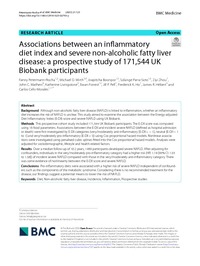Mostrar el registro sencillo de la publicación
Associations between an inflammatory diet index and severe non-alcoholic fatty liver disease: a prospective study of 171,544 UK Biobank participants
| dc.contributor.author | Petermann-Rocha, Fanny | |
| dc.contributor.author | Wirth, Michael D. | |
| dc.contributor.author | Boonpor, Jirapitcha | |
| dc.contributor.author | Parra‑Soto, Solange | |
| dc.contributor.author | Zhou, Ziyi | |
| dc.contributor.author | Mathers, John | |
| dc.contributor.author | Livingstone, Katherine M. | |
| dc.contributor.author | Forrest, Ewan | |
| dc.contributor.author | Pell, J.P. | |
| dc.contributor.author | Ho, Frederick | |
| dc.contributor.author | Hébert, James R | |
| dc.contributor.author | Celis-Morales, Carlos | |
| dc.date.accessioned | 2023-04-25T14:12:06Z | |
| dc.date.available | 2023-04-25T14:12:06Z | |
| dc.date.issued | 2023 | |
| dc.identifier.uri | http://repositorio.ucm.cl/handle/ucm/4706 | |
| dc.description.abstract | Background Although non-alcoholic fatty liver disease (NAFLD) is linked to infammation, whether an infammatory diet increases the risk of NAFLD is unclear. This study aimed to examine the association between the Energy-adjusted Diet Infammatory Index (E-DII) score and severe NAFLD using UK Biobank. Methods This prospective cohort study included 171,544 UK Biobank participants. The E-DII score was computed using 18 food parameters. Associations between the E-DII and incident severe NAFLD (defned as hospital admission or death) were frst investigated by E-DII categories (very/moderately anti-infammatory [E-DII< −1], neutral [E-DII−1 to 1] and very/moderately pro-infammatory [E-DII>1]) using Cox proportional hazard models. Nonlinear associa‑ tions were investigated using penalised cubic splines ftted into the Cox proportional hazard models. Analyses were adjusted for sociodemographic, lifestyle and health-related factors. Results Over a median follow-up of 10.2 years, 1489 participants developed severe NAFLD. After adjusting for confounders, individuals in the very/moderately pro-infammatory category had a higher risk (HR: 1.19 [95% CI: 1.03 to 1.38]) of incident severe NAFLD compared with those in the very/moderately anti-infammatory category. There was some evidence of nonlinearity between the E-DII score and severe NAFLD. Conclusions Pro-infammatory diets were associated with a higher risk of severe NAFLD independent of confound‑ ers such as the components of the metabolic syndrome. Considering there is no recommended treatment for the disease, our fndings suggest a potential means to lower the risk of NAFLD. | es_CL |
| dc.language.iso | en | es_CL |
| dc.rights | Atribución-NoComercial-SinDerivadas 3.0 Chile | * |
| dc.rights.uri | http://creativecommons.org/licenses/by-nc-nd/3.0/cl/ | * |
| dc.source | BMC Medicine, 21(1), 123 | es_CL |
| dc.subject | Diet | es_CL |
| dc.subject | Non-alcoholic fatty liver disease | es_CL |
| dc.subject | Incidence | es_CL |
| dc.subject | Infammation | es_CL |
| dc.subject | Prospective studies | es_CL |
| dc.title | Associations between an inflammatory diet index and severe non-alcoholic fatty liver disease: a prospective study of 171,544 UK Biobank participants | es_CL |
| dc.type | Article | es_CL |
| dc.ucm.indexacion | Scopus | es_CL |
| dc.ucm.indexacion | Isi | es_CL |
| dc.ucm.uri | bmcmedicine.biomedcentral.com/articles/10.1186/s12916-023-02793-y | es_CL |
| dc.ucm.doi | doi.org/10.1186/s12916-023-02793-y | es_CL |



